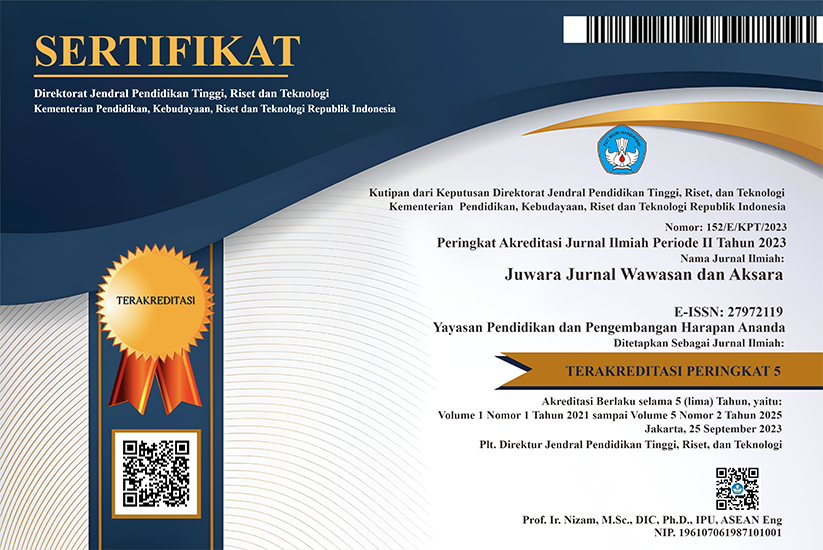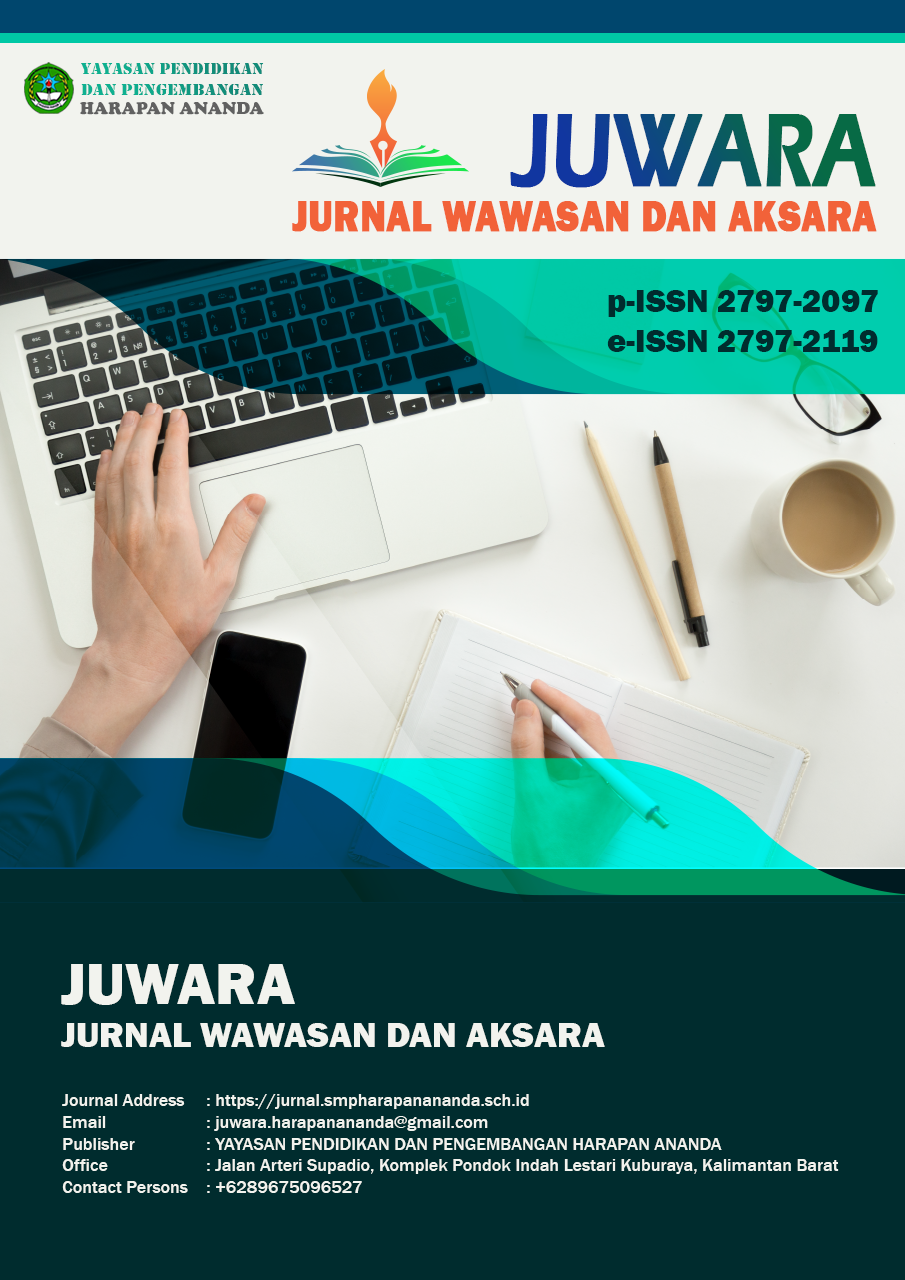Analisis SWOT Kebijakan Makan Siang Gratis di Sekolah Menengah Kejuruan
DOI:
https://doi.org/10.58740/juwara.v4i1.91Keywords:
Analisis SWOT, Makan Siang Gratis, Kecukupan Gizi, Kesehatan Siswa, Sekolah menengah kejuruan, swot analysis, free lunch, nutritional adequacy, vocational high schools, student healthAbstract
ABSTRAK
Penelitian ini bertujuan untuk menganalisis kebijakan makan siang gratis di sekolah menengah kejuruan di Indonesia melalui pendekatan analisis SWOT (Strengths, Weaknesses, Opportunities, and Threats). Metode penelitian yang digunakan adalah penelitian kepustakaan, dengan pengumpulan dan analisis data dari berbagai sumber sekunder. Hasil analisis menunjukkan program makan siang gratis memiliki kekuatan pada peningkatan kesehatan siswa, memberikan akses makanan bergizi, dan peningkatan prestasi akademik. Namun, kelemahannya keterbatasan anggaran, tantangan pemenuhan logistik, dan menambah beban administrasi pihak sekolah. Peluang yang dapat dimanfaatkan meliputi dukungan dari komunitas lokal, Kampanye kesadaran gizi, serta integrasi program dengan kurikulum. Ancaman yang harus diantisipasi mencakup ketidakstabilan harga pangan, Terjadinya peningkatan sampah plastik, dan masalah keamanan pangan. Penelitian ini memberikan wawasan yang mendalam tentang kekuatan, kelemahan, peluang, dan ancaman yang dihadapi oleh kebijakan makan siang gratis di sekolah menengah kejuruan. Temuan ini membuka peluang penelitian dimasa yang akan datang untuk evaluasi pelaksanaan program dalam jangka waktu yang panjang.
ABSTRACT
This research aims to analyze the free lunch policy in vocational high schools in Indonesia using a SWOT (Strengths, Weaknesses, Opportunities, and Threats) analysis approach. The research method used is library research, with data collection and analysis from various secondary sources. The results of the analysis show that the free lunch program has the power to improve student health, provide access to nutritious food, and increase academic achievement. However, the weaknesses are budget limitations, logistical challenges, and increased administrative burdens on schools. Opportunities that can be utilized include support from local communities, nutrition awareness campaigns, and curriculum integration with health education programs. Threats that must be anticipated include food price instability, an increase in plastic waste, and food safety problems. This research provides in-depth insight into the strengths, weaknesses, opportunities, and threats facing free lunch policies in vocational high schools. These findings open up future research opportunities to evaluate program implementation over a long period of time.
References
Anumpitan, J. P., Zuraida, R., & Nasution, S. H. (2023). The Correlation Between Food Intake And Nutritional Status of Primary Students: Literature Review. Medical Profession Journal of Lampung, 13(6), 1062–1068. https://doi.org/10.53089/MEDULA.V13I6.824
Asmare, B., Taddele, M., Berihun, S., & Wagnew, F. (2018). Nutritional status and correlation with academic performance among primary school children, northwest Ethiopia. BMC Research Notes, 11(1). https://doi.org/10.1186/S13104-018-3909-1
Eliza, F., Mudjiran, Neviyarni, Nirwana, H., Sardi, J., & Habibullah. (2024). KEPUASAN MAHASISWA TERHADAP BIMBINGAN DAN KONSELING AKADEMIK SECARA DARING OLEH DOSEN PEMBIMBING AKADEMIK. Jurnal Inovasi Pendidikan Dan Teknologi Informasi (JIPTI), 5(1), 199–205. https://doi.org/10.52060/JIPTI.V5I1.1970
Fadli, R., Surjono, H. D., Sari, R. C., Eliza, F., Hakiki, M., Hidayah, Y., Triyono, M. B., & Samala, A. D. (2024). Effectiveness of Mobile Virtual Laboratory Based on Project-Based Learning to Build Constructivism Thinking. International Journal of Interactive Mobile Technologies (IJIM), 18(06), 40–55. https://doi.org/10.3991/IJIM.V18I06.47643
Fauzan, M. A., Nurmalasari, Y., & Anggunan, A. (2021). Hubungan Status Gizi dengan Prestasi Belajar. Jurnal Ilmiah Kesehatan Sandi Husada, 10(1), 105–111. https://doi.org/10.35816/JISKH.V10I1.517
Gearan, E. C., & Fox, M. K. (2020). Updated Nutrition Standards Have Significantly Improved the Nutritional Quality of School Lunches and Breakfasts. Journal of the Academy of Nutrition and Dietetics, 120(3), 363–370. https://doi.org/10.1016/j.jand.2019.10.022
Gillies, C., Blanchet, R., Gokiert, R., Farmer, A., & Willows, N. D. (2022). Comprehensive Nutrition Interventions in First Nation-Operated Schools in Canada. Canadian Journal of Dietetic Practice and Research, 83(3), 128–132. https://doi.org/10.3148/CJDPR-2021-039
Kinderknecht, K., Harris, C., & Jones-Smith, J. (2020). Association of the Healthy, Hunger-Free Kids Act With Dietary Quality Among Children in the US National School Lunch Program. JAMA, 324(4), 359–368. https://doi.org/10.1001/JAMA.2020.9517
Lundborg, P., Rooth, D. O., & Alex-Petersen, J. (2022). Long-Term Effects of Childhood Nutrition: Evidence from a School Lunch Reform. The Review of Economic Studies, 89(2), 876–908. https://doi.org/10.1093/RESTUD/RDAB028
Masa, R., & Chowa, G. (2021). Household food insecurity and educational outcomes in school-going adolescents in Ghana. Public Health Nutrition, 24(6), 1349–1361. https://doi.org/10.1017/S1368980020001974
Mayurasakorn, K., Pinsawas, B., Mongkolsucharitkul, P., Sranacharoenpong, K., & Damapong, S. nga. (2020). School closure, COVID-19 and lunch programme: Unprecedented undernutrition crisis in low-middle income countries. Journal of Paediatrics and Child Health, 56(7), 1013–1017. https://doi.org/10.1111/JPC.15018
McKinzie, W. R., Bampasidou, M., Besse, C., Fannin, J. M., & Motsenbocker, C. E. (2023). Research Update: Engaging School Food Authorities in Local Procurement Economic Impact Study. Journal of Food Distribution Research, 54(1), 47–49.
Petchoo, J., Kaewchutima, N., & Tangsuphoom, N. (2022). Nutritional quality of lunch meals and plate waste in school lunch programme in Southern Thailand. Journal of Nutritional Science, 11. https://doi.org/10.1017/JNS.2022.31
Sholichah, F. (2021). TINGKAT KECUKUPAN GIZI, STATUS GIZI, DAN STATUS ANEMIA MAHASISWA PENGHAFAL AL QURAN DI UIN WALISONGO SEMARANG. Journal of Nutrition College, 10(1), 62–71. https://doi.org/10.14710/JNC.V10I1.28985
Susilowati, F., Lestari, N. E., & Shifa, N. A. (2021). Konsentrasi Belajar pada Anak Sekolah Dasar dapat di Pengaruhi oleh Sarapan Pagi dan Status Gizi. Jakarta Journal of Health Sciences, 1(01), 16–24. https://jakartajournals.net/index.php/oajjhs/article/view/6
Thompson, H. R., Machado, S. S., Madsen, K. A., Cauchon-Robles, R., Neelon, M., & Ritchie, L. (2022). Impact of a Teacher Intervention to Encourage Students to Eat School Lunch. International Journal of Environmental Research and Public Health, 19(18). https://doi.org/10.3390/IJERPH191811553
Downloads
Published
How to Cite
Issue
Section
License
Copyright (c) 2024 Fivia Eliza, Nurhizrah Gistituati, Rusdinal, Radinal Fadli

This work is licensed under a Creative Commons Attribution-NonCommercial 4.0 International License.
JUWARA: Jurnal Wawasan dan Aksara provides open access to anyone so that the information and findings in these articles are useful for everyone. This journal's article content can be accessed and downloaded for free, following the creative commons license used.




















